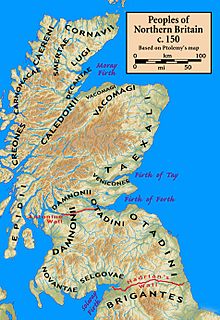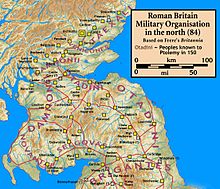Novantae facts for kids
The Novantae were an ancient group of people who lived in what is now Galloway and Carrick, in the southwest part of Scotland. They are mentioned in a very old book called Geography, written around 150 AD by a person named Ptolemy. This book is the only historical record we have about them.
Archaeologists have found evidence at a place called Rispain Camp, near Whithorn. This was a large, strong farmstead used between 100 BC and 200 AD. This shows that the people living there at that time were farmers.
We don't know for sure what their background was. Some people think they were Celtic Gaels, while others believe they spoke a Brythonic language. The area where they lived has a long history with different cultures, including Gaels, Picts, and Brythonic speakers. Because there isn't much information, it's hard to say for certain what their ethnic group was.
Contents
Ptolemy's Map and the Novantae
The most important historical mention of the Novantae comes from Ptolemy's book, Geography, written around 150 AD. He described their homeland and main settlements. No other ancient writings mention them.
Ptolemy's description helps us know exactly where the Novantae lived. He named some clear geographical features. For example, his "Novantarum Cheronesus" is the Rhins of Galloway, which is a peninsula. His "Novantarum promontory" is either Corsewall Point or the Mull of Galloway, which are points of land sticking out into the sea. These details help us pinpoint the Novantae to that specific area.
Ptolemy also said they had towns called Locopibium and Rerigonium. However, there weren't really towns in that area back then. He was probably talking about important native strongholds, like duns (fortified settlements) or royal courts.
Life During the Roman Era
We learn a lot about the Novantae during the Roman period from archaeological finds. They lived in small settlements, usually less than one hectare (about 2.5 acres) in size. These places were used from about 1000 BC all the way through the time of the Roman Empire.
The Novantae also built hillforts, which were strongholds on hills, and a few crannogs (settlements built on artificial islands in lakes) and brochs (round stone towers). During the Roman era, they started building stone-walled huts.
It's thought that the Novantae had an important center at Clatteringshaws near Kirkcudbright. This place started as a fenced area and later became a fort with timber and stone walls. It was abandoned by the Roman period, but the Romans might have used it for military practice, even building two practice camps nearby and pretending to attack it.
The Romans didn't have a big military presence in Novantae territory. There was only a small fort at Gatehouse of Fleet, in the southeastern part of their land. Most Roman items found there are small things that could be carried or moved. This lack of Roman structures is very different from the many native settlements and strongholds found. For example, Rispain Camp, once thought to be Roman, is now known to be a large fortified farmstead used by the native people before and during the Roman period.
Gnaeus Julius Agricola, a Roman governor, led campaigns in Scotland between 78 and 84 AD. The Roman historian Tacitus wrote about these campaigns but didn't give specific details about the Novantae. He mentioned that Agricola built forts in conquered areas and campaigned as far as the Firth of Tay. Later, the Novantae were said to have caused problems near Hadrian's Wall, and the fort at Gatehouse of Fleet was likely used to control them.
The Novantae After the Romans
After the Romans left, the name Novantae disappears from historical records. This is probably because "Novantae" was the Roman name for these people, and they didn't use it themselves. Their land later became part of new kingdoms like Rheged and Gododdin.
However, a kingdom called Novant is mentioned in an old Welsh poem called Y Gododdin. This poem, written by Aneirin, tells the story of the Battle of Catraeth. In this battle, an army from Gododdin tried to attack the Angles of Bernicia, but it didn't go well. The poem praises the warriors who fought, including the "Three Chiefs of Novant" and their many followers. This "Novant" is clearly linked to the ancient Novantae tribe from the Iron Age.
See also
Images for kids




